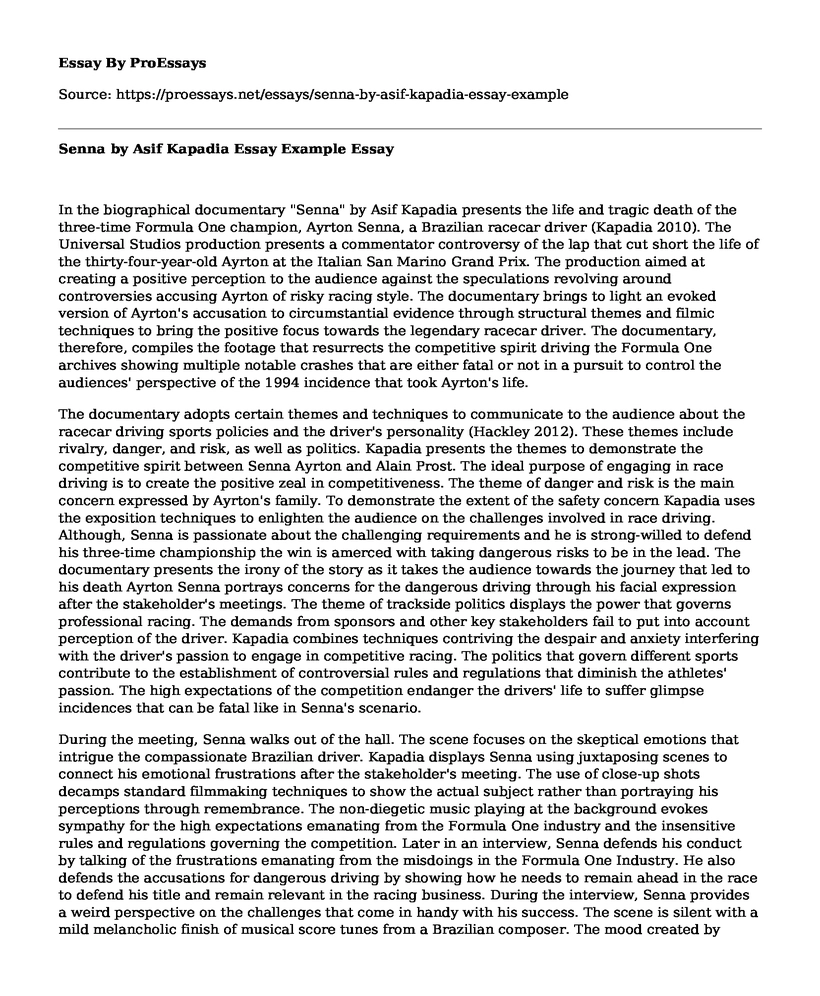In the biographical documentary "Senna" by Asif Kapadia presents the life and tragic death of the three-time Formula One champion, Ayrton Senna, a Brazilian racecar driver (Kapadia 2010). The Universal Studios production presents a commentator controversy of the lap that cut short the life of the thirty-four-year-old Ayrton at the Italian San Marino Grand Prix. The production aimed at creating a positive perception to the audience against the speculations revolving around controversies accusing Ayrton of risky racing style. The documentary brings to light an evoked version of Ayrton's accusation to circumstantial evidence through structural themes and filmic techniques to bring the positive focus towards the legendary racecar driver. The documentary, therefore, compiles the footage that resurrects the competitive spirit driving the Formula One archives showing multiple notable crashes that are either fatal or not in a pursuit to control the audiences' perspective of the 1994 incidence that took Ayrton's life.
The documentary adopts certain themes and techniques to communicate to the audience about the racecar driving sports policies and the driver's personality (Hackley 2012). These themes include rivalry, danger, and risk, as well as politics. Kapadia presents the themes to demonstrate the competitive spirit between Senna Ayrton and Alain Prost. The ideal purpose of engaging in race driving is to create the positive zeal in competitiveness. The theme of danger and risk is the main concern expressed by Ayrton's family. To demonstrate the extent of the safety concern Kapadia uses the exposition techniques to enlighten the audience on the challenges involved in race driving. Although, Senna is passionate about the challenging requirements and he is strong-willed to defend his three-time championship the win is amerced with taking dangerous risks to be in the lead. The documentary presents the irony of the story as it takes the audience towards the journey that led to his death Ayrton Senna portrays concerns for the dangerous driving through his facial expression after the stakeholder's meetings. The theme of trackside politics displays the power that governs professional racing. The demands from sponsors and other key stakeholders fail to put into account perception of the driver. Kapadia combines techniques contriving the despair and anxiety interfering with the driver's passion to engage in competitive racing. The politics that govern different sports contribute to the establishment of controversial rules and regulations that diminish the athletes' passion. The high expectations of the competition endanger the drivers' life to suffer glimpse incidences that can be fatal like in Senna's scenario.
During the meeting, Senna walks out of the hall. The scene focuses on the skeptical emotions that intrigue the compassionate Brazilian driver. Kapadia displays Senna using juxtaposing scenes to connect his emotional frustrations after the stakeholder's meeting. The use of close-up shots decamps standard filmmaking techniques to show the actual subject rather than portraying his perceptions through remembrance. The non-diegetic music playing at the background evokes sympathy for the high expectations emanating from the Formula One industry and the insensitive rules and regulations governing the competition. Later in an interview, Senna defends his conduct by talking of the frustrations emanating from the misdoings in the Formula One Industry. He also defends the accusations for dangerous driving by showing how he needs to remain ahead in the race to defend his title and remain relevant in the racing business. During the interview, Senna provides a weird perspective on the challenges that come in handy with his success. The scene is silent with a mild melancholic finish of musical score tunes from a Brazilian composer. The mood created by Kapadia reflects on the strong nationalism help by Senna.
Conclusion
Kapadia develops the theme of rivalry using the mood and tone film techniques to show the disagreement and competition between Senna and his close rival Alain Prost. From the archived footage, the two teammates drifted apart due to their responsibilities and expectations demanded the Formula One in the incidence of the 1989 Grand Prix, Japan. Further, Kapadia condemns the level of safety upheld by the racing federation to safeguard the drivers' lives. The film shows the negative appeal of the producer trying to defend the safety precautions taken to ensure that racing remains safe for drivers. He advocates proper safety measures to reduce the fatal probabilities of the drivers by securing the racing zones and moderation of speed limits.
References
Hackley, Brianna Chanel. "Rhetoric of Social change in Documentary Film Scores: An Analysis of the Cove" 2012. Master's Theses, 4134.
https://alchetron.com/Alain-Prost 9 may 18
Kapadia, Asif. "Senna: A movie, Manish Pandey" ESPN/Working Title, 2010.
Cite this page
Senna by Asif Kapadia Essay Example. (2022, May 26). Retrieved from https://proessays.net/essays/senna-by-asif-kapadia-essay-example
If you are the original author of this essay and no longer wish to have it published on the ProEssays website, please click below to request its removal:
- The Future of Design Teams and BIM Essay
- Narrative Situation of Story Paper Example
- Assignment Example on Intercultural Communication
- Research Paper on Cultural, Political and Social Identity of the South Asian People
- Essay Example on Understanding the Difference Between Culture and Fashion
- Opposites Attract: The Journey of Love From Attraction to Marriage - Essay Sample
- What a Good City Should Do - Free Paper Sample







